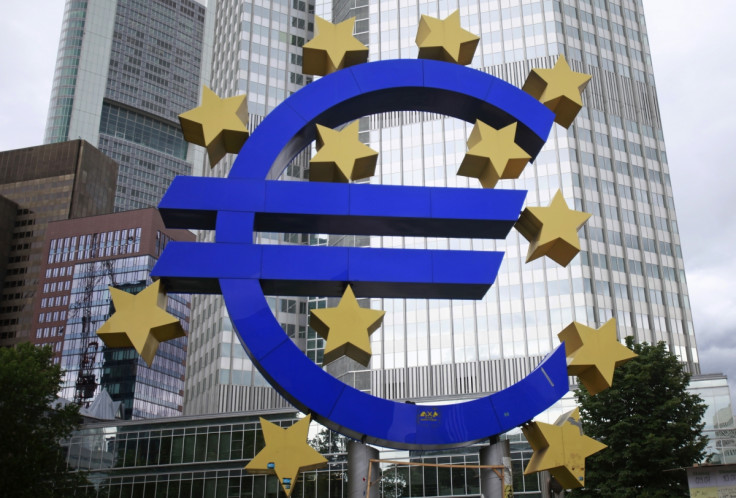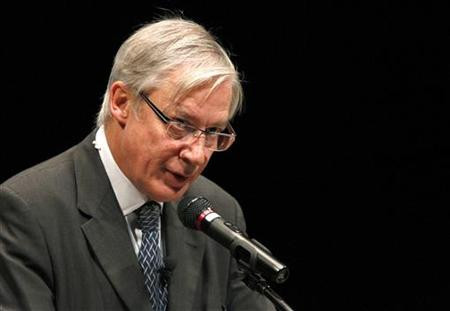ECB Monetary Policy Explained: What Eurozone Rates Decision Means

If you're not a wonk, a politico, a banker or an economist then jargon such as "negative deposit rate" and "targeted long-term refinancing operation" are a snoresome quench to any embers of curiosity about what the hell is going on at the European Central Bank.
But take a moment to scaffold your eyelids with matchsticks because the ECB's recent decisions and the debate around them are of vast importance.
Here's a digestible guide to the ECB's recent monetary policy moves.
What is happening?
The ECB will cut its benchmark interest rate to 0.15% from 11 June, a new record low. Before, it had been 0.25%.
This rate informs other interest rates in the eurozone economy. By cutting it further, the ECB hopes to bring down interest rates even more on bank loans.
Ultimately, the ECB wants banks to lend more to businesses. This is because bank lending is falling in the 18-member state eurozone.
Though the eurozone economy is growing again after several years of financial crisis, there are concerns that the recovery is not sustainable, in large part due to falling bank lending.
Bank lending is a way of increasing the money supply. Growth relies on there being more money around for consumers to spend and businesses to invest in expanding their output and hiring more staff.
So if banks aren't lending much then the prospects for economic growth are limited. Hence to stimulate the flow of more credit, the ECB has slashed its key rate in the hope that borrowing costs will fall for firms.
But the ECB hasn't just cut its benchmark rate. It has also cut its deposit rate to a negative figure – minus 0.1%.
The ECB has a "deposit facility", which means banks can hold some of their excess cash at the central bank. Sort of like a current account, the ECB pays interest on those deposits.
Now that the deposit rate is negative, it will steadily chip away at the cash banks leave with it. This is to encourage banks to lend their cash out rather than hold it with the ECB.
It also slashed its marginal lending facility – where it offers cheap overnight credit to banks in need to some quick funds – to 0.4% from its previous 0.75%.
What's all this about LTROs and TLTROs?
The ECB conducts what are called long-term refinancing operations (LTROs). This is basically a system for banks with illiquid assets – those they can't sell.
So the ECB will inject liquidity into banks by letting them use these unfavourable assets as collateral for cheap loans with lifespans of up to 36 months.
In the financial markets, banks would not be able to get hold of loans by using these assets as collateral, meaning they can get funding that would otherwise be unavailable to them through the ECB's LTRO window.
The ECB hopes the banks will then have more capital with which to fund lending to businesses.

But the ECB has taken LTROs one step further. It will start "targeted LTROs" (TLTRO) between March 2015 and June 2016 – worth €400bn (£323bn, $542bn) in all.
Without getting too bogged down in the details, banks will be able to get hold of more cheap funding relative to the amount they lend to non-financial businesses from 30 April, 2014.
In fact, they can get hold of as much as 7% of the value of this lending at an interest rate of just 0.25% - dirt cheap credit.
The ECB intends this to incentivise more lending to firms because banks will be able to get hold of a larger amount of discounted funding, reducing the cost of running their operations.
And there still may be more to come. The ECB has "intensified" its work looking at the possibility of outright purchases of asset-backed securities (ABS).
ABS are financial products constructed from banks' loan assets. For example, a bank may package together some of its mortgage lending, a process called securitisation.
It will then sell the combined package – a security – to an investor, who will make money on the dividend payments sourced from the interest on the mortgage repayments.
It was residential mortgage-backed assets that were a major part of triggering the financial crisis, when homeowners in the US began defaulting after the Federal Reserve hiked interest rates.
Lots of these assets are now illiquid, meaning the banks that own them can't raise money by selling them on. If the ECB were to buy up such assets it could provide a significant source of funding for eurozone banks. But this would also mean the ECB taking on the ABS risk.
Why is all this being done again?
Because banks aren't lending enough into the eurozone economy. Cheaper interest rates and lower bank funding costs should, in theory, mean financial institutions lend more.
And they need to lend more to support economic growth, which was just 0.3% in the first quarter of 2014. More money for consumers and firms, which mostly comes from bank lending, means more output and jobs. This would then make the eurozone's current weak recovery sustainable.
It would also stave off deflationary fears, with inflation hovering precariously close to the zero mark (0.5% in May), by increasing the money supply and pushing up prices. Higher prices with steady inflation mean more money for firms, again leading to more jobs, higher wages and economic growth.
If deflation were to occur, it would spark something called a "liquidity trap". This is where banks, businesses and individuals hold onto money because it will naturally increase in value as prices deflate. By holding onto cash it is not spent or invested – harming economic growth.
It is at this point that actions by the ECB would have little or no impact. Cutting interest rates wouldn't lead to bank lending, because deflation means hoarding money would produce a greater gain at less risk than lending it out at interest.
The problem for the ECB is that by taking such extraordinary steps to increase bank lending and prevent deflation, they may actually end up encouraging it.
If banks looking ahead think deflation will begin, they may start to hold on to their capital. This will then reduce their lending, limiting the money supply and pushing prices into deflation as firms discount heavily to encourage spending rather than hoarding.
This self-fulfilling deflation cycle is something that is concerning the ECB policymaker Christian Noyer. He is warning of the development of "a perverse feedback loop".
Will it all come off?
Whether this extra ECB effort will work remains to be seen. Monetary policy has already been incredibly loose and interest rates low for years, yet still bank lending is falling.
This is in part due to regulatory demands that banks hold more protective capital against their lending, to prevent taxpayers having to bail out institutions again like they did during the financial crisis.
One way to do this is to increase your capital. Another, cheaper, way is to reduce your lending – and that's what we're seeing.
Who knows if the ECB's latest batch of policy decisions can reconcile this seemingly irreconcilable situation. Most are desperately hoping it does, because eurozone deflation will have serious consequences not just for those using the euro currency, but for the wider global economy too.
© Copyright IBTimes 2025. All rights reserved.






















